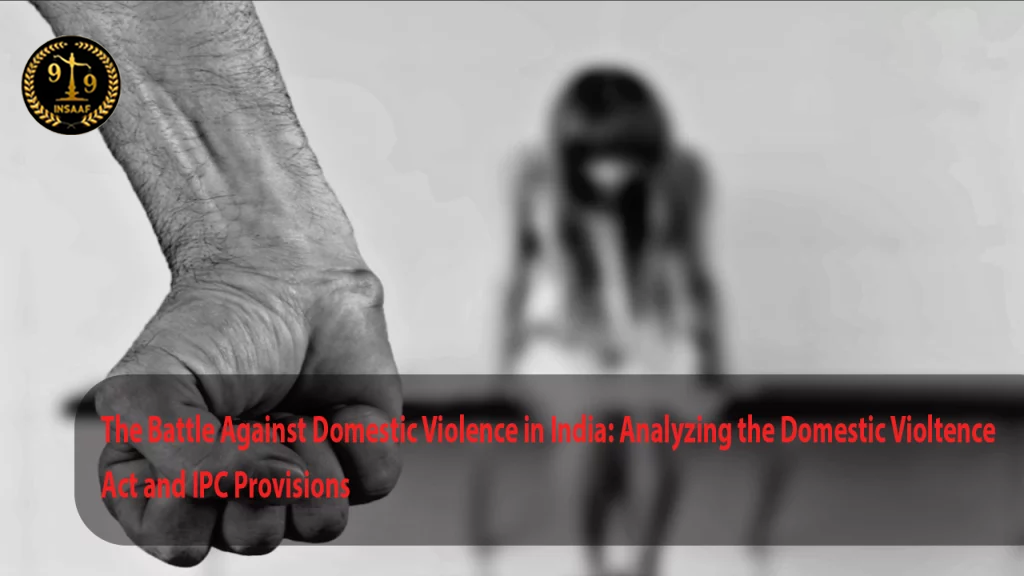

Online Legal Advice from Insaaf99® Online Lawyer Consultation in India


Online Legal Advice from Insaaf99® Online Lawyer Consultation in India

Domestic violence act is a global issue that perpetuates an ongoing cycle of abusive behavior within intimate relationships. Its primary aim is to establish and maintain dominance over a partner. This form of violence encompasses physical, sexual, emotional, and financial abuse, with severe consequences.
Women disproportionately bear the brunt of domestic violence's devastating consequences. It results in physical injuries, mental health issues, and even fatalities. Victims of domestic violence, predominantly women, face heightened risks of homelessness, poverty, and joblessness. They are also more prone to substance abuse and a range of health problems, including chronic pain, heart disease, and cancer.
Children exposed to domestic violence face potential long-term emotional and behavioral consequences. They may be at an elevated risk of developing conditions like anxiety, depression, and post-traumatic stress disorder.
To counteract this social issue, the government has introduced several legal provisions, notably the Protection of Women from Domestic Violence Act and relevant sections of the Indian Penal Code (IPC). This article explores these legal safeguards and their pivotal role in addressing domestic violence in India.
The Protection of Women from Domestic Violence Act, enacted in 2005, marks a critical development in India's legal landscape. It emerged to combat domestic violence against women, addressing the inadequacies of previous laws. This legislation aimed to bring domestic violence out of obscurity, recognizing women's rights to a violence-free home.
The Act's defining feature is its all-encompassing definition of domestic violence. It encompasses not only physical abuse but also verbal, emotional, and economic forms of abuse. This broad definition acknowledges the multifaceted nature of domestic violence.
Protection Orders: Courts can issue protection orders to prevent further violence.
Residence Orders: Women can retain their shared residence or receive alternative housing.
Monetary Relief: Financial aid addresses immediate and long-term needs.
Custody Orders: Child custody decisions are made in their best interest.
Counselling and Support: Counseling services help survivors cope with trauma.
The Act has transformed the lives of countless women, providing legal recourse and empowering survivors. It has also catalyzed societal change, raising awareness about domestic violence and reinforcing the idea that it's a crime not to be tolerated.

The problem of domestic violence in India is extensive and deeply entrenched in societal norms. This section sheds light on the widespread nature of this issue, emphasizing the urgent requirement for legal safeguards.
Domestic violence in India knows no geographic, social, or economic boundaries. It impacts women from various backgrounds, transcending regional and demographic constraints. The expressions of domestic violence are multifaceted, ranging from physical harm and emotional distress to economic exploitation and psychological manipulation. The diverse nature of this problem highlights the critical need for comprehensive interventions.
The Indian Penal Code is a crucial legal framework for addressing domestic violence in India. This section explores the distinct IPC provisions designed to tackle domestic violence and their consequences for victims and offenders.
These are the relevant IPC sections that directly tackle domestic violence:
Section 498A: Addresses cruelty against married women and punishes those subjecting women to cruelty.
Section 304B: Deals with dowry deaths, holding those responsible accountable for their actions.
Section 306: Pertains to abetment to suicide and is invoked when a woman takes her own life due to the cruelty or harassment she faces within her marital home.
Legal interventions through the Protection of Women from Domestic Violence Act and relevant IPC provisions have been instrumental in transforming the lives of countless women.
Legal safeguards have played a pivotal role in empowering survivors to break free from abusive relationships, ensuring their safety and well-being.
These legal interventions offer women a lifeline, an opportunity to rebuild their lives, and the assurance that they need not suffer domestic violence in silence
In conclusion, the Protection of Women from Domestic Violence Act and relevant IPC provisions are central to India's battle against domestic violence. These legal interventions provide women with a shield against the physical, emotional, and economic abuse that they often suffer silently behind closed doors. These frameworks also empower survivors with recourse, financial relief, and emotional support. They hold perpetrators accountable, acting as a deterrent against future violence, all while raising awareness and reshaping societal attitudes.
Also Read